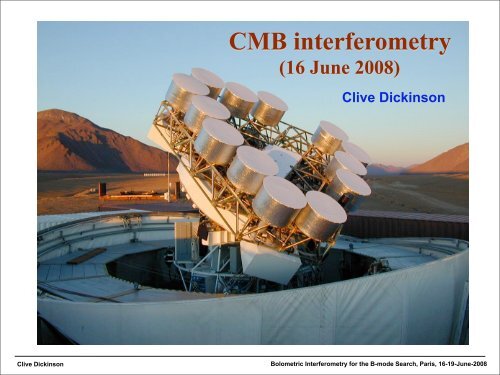CMB Interferometry - APC
CMB Interferometry - APC
CMB Interferometry - APC
You also want an ePaper? Increase the reach of your titles
YUMPU automatically turns print PDFs into web optimized ePapers that Google loves.
<strong>CMB</strong> interferometer experiments (1)I *thought* the first interferometric <strong>CMB</strong> measurements were by R.D. Davies & A.N.Lasenby at Jodrell Bank (U. Manchester)But I was wrong!– They published 5GHz single dish “wagging” (Lasenby & Davies, 1983, MNRAS, 203, 1137)– Mk1/Mk2 baseline was unpublished due to lack of sensitivity (and probably other issues!)Clive Dickinson5Bolometric <strong>Interferometry</strong> for the B-mode Search, Paris, 16-19-June-2008
<strong>CMB</strong> interferometers (3)First detections by an interferometer wasCambridge Anisotropy Telescope (CAT)– Cambridge/Jodrell Bank/IAC collaboration– 3-horn reflector antennas at Cambridge (UK!)– 15.5/16.5 GHz, ~2deg primary beam– Measurements at l~500 (e.g. Scott et al. 1996)Clive Dickinson7Bolometric <strong>Interferometry</strong> for the B-mode Search, Paris, 16-19-June-2008
<strong>CMB</strong> interferometer experiments (4)Jodrell Bank-IAC 33 GHz interferometer(Harrison et al. 2001)Jodrell Bank 5 GHz interferometer(Melhuish et al. 1999; Giardino et al.2001)Clive Dickinson8Bolometric <strong>Interferometry</strong> for the B-mode Search, Paris, 16-19-June-2008
<strong>CMB</strong> interferometers (5)Very Small Array (VSA) located at Tenerife– Cambridge/Jodrell Bank/IAC– 14 elements -> n(n-1)/2 = 91 baselines!– 26-36 GHz tunable, 1.5 GHz bandwidth– Multiple configurations: l~130-2000– High filling factor to give good surfacebrightness sensitivityΔT ≈ fΔSλ22kΩDickinson et al. (2004)Clive Dickinson9Bolometric <strong>Interferometry</strong> for the B-mode Search, Paris, 16-19-June-2008
<strong>CMB</strong> interferometer (6)Degree Angular Scale Interferometer (DASI) & CosmicBackground Imager (CBI)– Sister instruments (many parts in common)– 13 antennas 26-36 GHz band (1GHz band to limit bandwidthsmearing)– DASI l~100-1000– CBI l~500-3500CBI high-l “excess” (probably SZ)– Watch out for new results (Sievers et al., in prep.)Among the first polarization measurements!– Kovac et al. (2002); Readhead et al. (2004)Mason et al. (2003) Sievers et al. (2007)Clive Dickinson10Bolometric <strong>Interferometry</strong> for the B-mode Search, Paris, 16-19-June-2008
<strong>CMB</strong> interferometers (7)High frequency interferometers coming on-line:Array for Microwave Background Anisotropy (AMiBA)– 94GHz, 7,13 elements, at Mauna LoaMillimetre-wave Bolometer Interferometer (MBI)– 1st bolometer interferometer? (Tucker et al. 2003)….Likely more on their way in the near future…– (BRAIN, GUBBINS, CBI3…)http://amiba.asiaa.sinica.edu.tw/Clive Dickinson11Bolometric <strong>Interferometry</strong> for the B-mode Search, Paris, 16-19-June-2008
VSA & CBI experienceVSA & CBI data are remarkably easy to analyze once geometry is worked out– Look for “bad” data and flag– Correlated emission (e.g. clouds!) easy to identify (phase is very sensitive)– Check calibration carefully– Average data in u,v-plane (~10000 samples)– Approximate covariance matrix and likelihoodVSA suffered from “spurious correlated signal”– Probably *direct* cross-coupling between antennas– Worst on short baselines– Fringe-rate filtering worked very well!!!– Also filter other sources e.g. Sun & Moon!CBI suffered from ground spilloverJupiter– Comounted has benefits (constant u,v) but does not allow fringe-rate filtering!!– Lead/trail subtraction or multi-field projection worked well but reduced sensitivityClive Dickinson12Bolometric <strong>Interferometry</strong> for the B-mode Search, Paris, 16-19-June-2008
Amplitude / phase calibrationVSA & CBI were remarkably stable instruments– Good sites helped!Flux calibration accurate to typically ~1% orbetter (e.g. Hafez et al. 2008)Phase calibration was stable for many hours– No need for regular “phase tracking” (e.g. asin VLA)Hafez et al. (2008)CBI polarization was particularly “easy”– ~half receivers LCP and other half RCP– Baselines gave LL,RR,LR,RL– Deck rotations gave full combinations– Total intensity calibration by LL/RR baselinesindependently– Only polarization calibration was L-R phasedifference Tau-A at -27.6 deg. (stable enough tointerpolate over months!)Clive Dickinson13Bolometric <strong>Interferometry</strong> for the B-mode Search, Paris, 16-19-June-2008
ConclusionsInterferometers are good!However, bolometer interferometry is somewhat different– Adding (not multiplying) interferometer– Requires phase-shifters to measure cross-term– Ultimately, can get the same visibilities (Charlassier et al. 2008)– I am here to learn!(Tucker et al. 2003)Clive Dickinson14Bolometric <strong>Interferometry</strong> for the B-mode Search, Paris, 16-19-June-2008
















